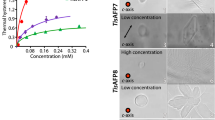Abstract
The insect spruce budworm (Choristoneura fumiferana) produces antifreeze protein (AFP) to assist in the protection of the over-wintering larval stage and contains multiple isoforms. Structures for two isoforms, known as CfAFP-501 and CfAFP-337, show that both possess similar left-handed β-helical structure, although thermal hysteresis activity of the longer isoform CfAFP-501 is three times that of CfAFP-337. The markedly enhanced activity of CfAFP-501 is not proportional to, and cannot be simply accounted for, by the increased ice-binding site resulting from the two extra coils in CfAFP-501. In order to investigate the molecular basis for the activity difference and gain better understanding of AFPs in general, we have employed several different computational methods to systematically study the structural properties and ice interactions of the AFPs and their deletion models. In the context of intact AFPs, a majority of the coils in CfAFP-501 has better ice interaction and causes stronger ice lattice disruption than CfAFP-337, strongly suggesting a cooperative or synergistic effect among β-helical coils. The synergistic effect would play a critical role and make significant contributions to the antifreeze activity β-helical antifreeze proteins. This is the first time that synergistic effect and its implication for antifreeze activity are reported for β-helical antifreeze proteins.
Similar content being viewed by others
References
Raymond J A, Devries A L. Adsorption inhibition as a mechanism of freezing resistance in polar fish. P Natl Acad Sci USA, 1977, 74: 2589–2593
Doucet D, Tyshenko M G, Davies P L, Walker V K. A family of expressed antifreeze protein genes from the moth, Choristoneura fumiferana. Eur J Biochem, 2002, 269: 38–46
Graether S P, Kuiper M J, Gagne S M, Walker V K, Jia Z, Sykes B D, Davies P L. β-helix structure and ice-binding properties of a hyperactive antifreeze protein from an insect. Nature, 2000, 401: 325–328
Leinala E K, Davies P L, Jia Z. Crystal structure of β-helical antifreeze protein points to a general ice binding model. Structure, 2002, 10: 619–627
Leinala E K, Davies P L, Doucet D, Tyshenko M G, Walker V K, Jia Z. A β-helical antifreeze protein isoform with increased activity. J. Biol Chem, 2002, 277: 33349–33352
Cornell W D, Cleplak P, Bayly C I, Gould I R, Merz K M, Ferguson D M, Spellmeyer D C, Fox T, Caldwell J W, Kollman P A. A second generation force field for the simulation of proteins and nucleic acids. J Am Chem Soc, 1995, 117: 5179–5197
Dewar M J S, Zoebisch E G, Healy E F, Stewart J J P. AM1: a new general purpose quantum mechanical model. J Am Chem Soc, 1985, 107: 3902–3909
Stewart J J P. Optimization of parameters for semi-empirical methods I-method. J Comp Chem, 1989, 10: 209–220
Chen G J, Jia Z. Ice-binding surface of fish type III antifreeze. Biophys J, 1999, 77: 1602–1608
Cheng Y H, Yang Z Y, Tan H W, Liu R Z, Chen G J, Jia Z. Analysis of ice-binding sites in fish type II antifreeze protein by quantum mechanics. Biophys J, 2002, 83: 2202–2210
Yang Z, Zhou Y, Liu K, Cheng Y, Liu R, Chen G, Jia Z. Computational study on the function of water within a beta-helix antifreeze protein dimer and in the process of ice-protein binding. Biophys J, 2003, 85: 2599–2605
Liu K, Jia Z, Chen G J, Tung C H, Liu R Z. Systematic size study of an insect antifreeze protein and its interaction with ice. Biophys J, 2005, 88: 953–958
Author information
Authors and Affiliations
Corresponding author
Additional information
Supported by the National Natural Science Foundation of China (Grant Nos. 26073011, 20231010, 20503002 and 20631020) and the Major State Basic Research Development Programs (Grant No. G2004CB719900)
Rights and permissions
About this article
Cite this article
Zhou, Y., Tan, H., Yang, Z. et al. Molecular basis for antifreeze activity difference of two insect antifreeze protein isoforms. SCI CHINA SER B 50, 266–271 (2007). https://doi.org/10.1007/s11426-007-0027-7
Received:
Accepted:
Issue Date:
DOI: https://doi.org/10.1007/s11426-007-0027-7



